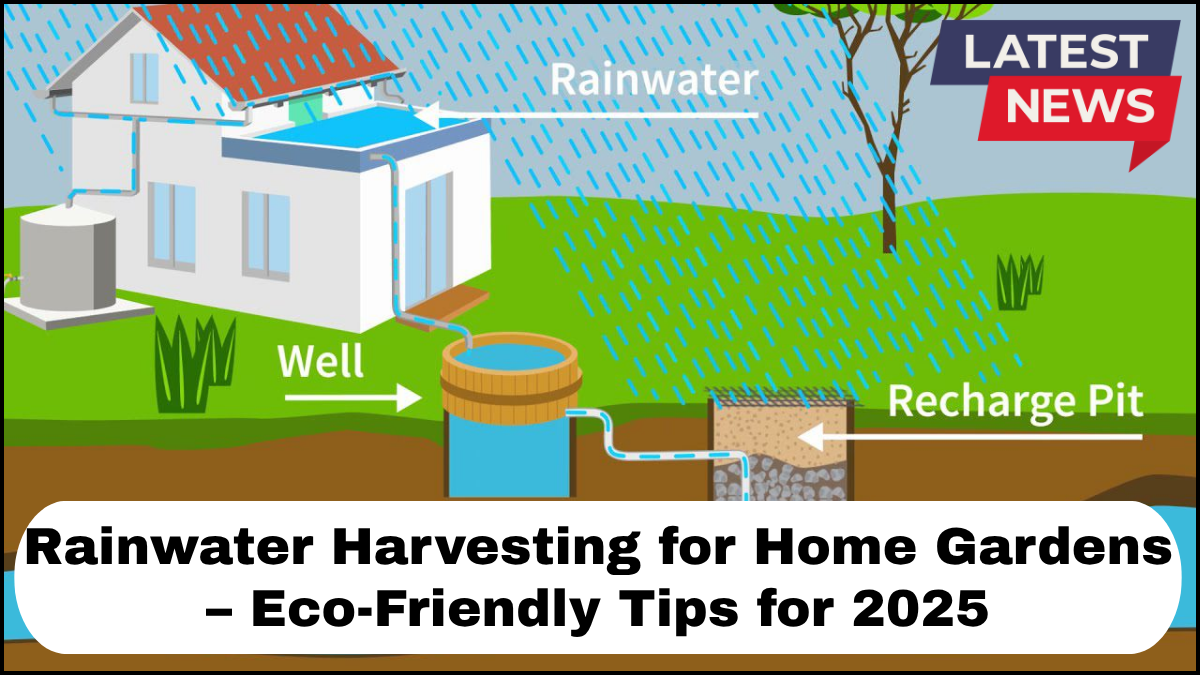As climate change and water scarcity become more pressing, homeowners are turning to rainwater harvesting for gardens as a sustainable solution. In 2025, eco-friendly gardening is no longer a niche practice—it’s a necessity. Collecting and reusing rainwater not only conserves resources but also promotes healthier plants, reduces utility bills, and minimizes runoff pollution.

Let’s explore practical, modern strategies to set up an efficient rainwater harvesting system tailored to your home garden.
Why Rainwater Harvesting Matters in 2025
Water conservation is now a key pillar in responsible landscaping. Municipal water systems are under stress, especially in urban and drought-prone areas. By harvesting rainwater, you reduce dependence on treated tap water and support the local ecosystem.
Rainwater is naturally soft and free of salts and chemicals commonly found in city water, making it ideal for gardens. Whether you’re growing vegetables, herbs, or ornamental plants, using harvested rainwater can significantly improve soil health and plant vitality.
Core Components of a Rainwater Harvesting System
An effective rainwater harvesting garden setup includes the following elements:
1. Catchment Area (Rooftop or Canopy)
Your roof is the most common and efficient surface for collecting rainwater. Ensure it’s made of safe, non-toxic materials (like tile or metal) that won’t leach harmful substances into the water.
2. Gutters and Downspouts
Clean and properly sloped gutters are essential for channeling water to your storage system. Install leaf guards or debris screens to prevent clogging.
3. First-Flush Diverters
This component ensures that the initial runoff, which may contain dust, bird droppings, or other contaminants, is discarded before water enters the tank.
4. Storage Tanks or Barrels
Choose tanks based on your space and volume needs. Options include:
-
Barrels (50–100 gallons): Ideal for small gardens or patios.
-
Underground Cisterns (500+ gallons): Best for larger landscapes.
Look for food-grade materials and UV-resistant designs to prevent algae growth.
5. Distribution System
Simple gravity-fed hoses or pump-driven drip irrigation systems can efficiently distribute stored rainwater to your garden beds.
Smart Techniques to Maximize Water Use in the Garden
1. Timing Matters
Water your plants early in the morning or late in the afternoon to reduce evaporation loss.
2. Mulching
Apply organic mulch like bark, straw, or compost to retain soil moisture and suppress weeds.
3. Plant Selection
Choose native and drought-tolerant species that thrive with minimal watering. Group plants by water needs for efficient irrigation.
4. Soil Health
Healthy soil acts like a sponge. Incorporate compost and organic matter to improve absorption and reduce runoff.
Tech-Driven Innovations for Rainwater Harvesting in 2025
Modern systems now include:
-
Smart Water Level Sensors: Monitor tank levels via mobile apps.
-
Automated Irrigation Timers: Connect to your rainwater storage for precision watering.
-
Modular Tank Designs: Stackable or wall-mounted barrels save space in compact urban homes.
These innovations make eco-friendly gardening more accessible, even for beginners.
Regulatory and Maintenance Considerations
Before installation, check local regulations. Some regions have restrictions or incentives for rainwater collection. Always maintain your system by:
-
Cleaning gutters and screens monthly.
-
Inspecting tanks for leaks or blockages.
-
Treating stored water if it’s used for edible crops (use filters or UV treatment).
Environmental and Financial Benefits
A well-planned rainwater harvesting system offers long-term benefits:
-
Cuts down water bills by 30–50%.
-
Reduces stormwater runoff, which can carry pollutants into rivers and lakes.
-
Improves plant resilience and reduces dependence on synthetic fertilizers due to richer, chemical-free water.
FAQs: Rainwater Harvesting Garden in 2025
Q1: Is rainwater safe for all types of garden plants?
Yes, rainwater is generally ideal for most plants. However, if you collect it from roofs with potential contaminants, consider using filters before watering edible crops.
Q2: How much rainwater can I collect from my roof?
As a rule of thumb, you can collect about 600 gallons of water per inch of rain per 1,000 square feet of roof.
Q3: What’s the cost of installing a basic rainwater harvesting system?
Small DIY systems start around $100–$300, while larger, automated setups may cost $1,000 or more, depending on size and features.
Q4: Do I need a permit to install a system at home?
It depends on your location. Some cities encourage it with rebates; others may require permits. Always check local guidelines first.
Q5: Can I integrate rainwater harvesting with drip irrigation?
Absolutely. Many homeowners connect stored water to drip systems using gravity or low-power pumps for efficient watering.
click here to learn more